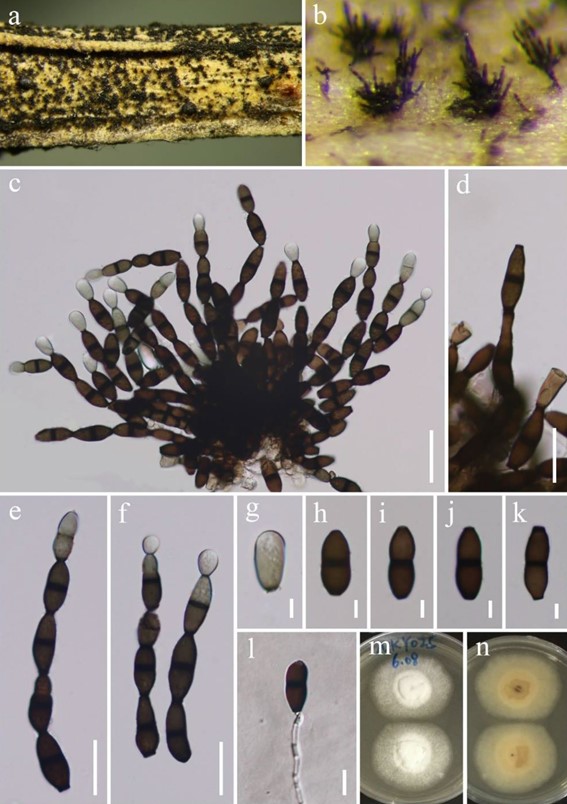Catenuliconidia uniseptata N.G. Liu & K.D. Hyde, in Yuan et al., Fungal Diversity: 10.1007/s13225-020-00461-7, [97] (2020)
Index Fungorum number: IF 556465; MycoBank number: MB 556465; Facesoffungi number: FoF 06117; Fig. 68
Etymology – Named after its 1-septate conidium.
Holotype – MFLU 19-0689.
Saprobic on decaying wood. Colonies on natural substrates effuse, black, velvety. Mycelium mostly immersed, composed of septate, branched, hyaline hyphae. Conidiophores macronematous, mononematous, in groups, erect, straight or broadly curved, cylindrical, brown to dark brown, septate, unbranched, smooth, thick-walled. Conidiogenous cells blastic, terminal, integrated, cylindrical, brown. Conidia 17.5–24.5 × 6.0–9.5 μm (x̄ = 21.4 × 8.0 μm, n = 30), catenate, developing in acropetal chains, ellipsoid to cylindrical, 1-septate, septum darkened, constricted at the septum, truncate at both ends, subhyaline to olive green when immature, brown to dark brown when mature.
Culture characteristics – Conidia germinating on water agar within 24 h and producing germ tubes from one or both ends. Colonies growing slowly on PDA medium, surface velvety, with entire edge, white, center fairly dense and protuberant, middle ring flat, outer ring sparse from above; center yellow, color decreasing from the center to periphery from below.
Material examined – CHINA, Guizhou Province, Guiyang, Guizhou Academy of Agricultural Sciences, on decaying wood, 27 May 2018, N.G. Liu, NKY025 (MFLU 19-0689, holotype); ex-type living culture, GZCC 20-0036.
GenBank accession numbers – ITS: MK804515; LSU: MK804516; SSU: MK804519; TEF1: MK828509; RPB2: MK828513.
Notes – Phylogenetically, Corynesporopsis belongs to Xylariaceae, while Catenuliconidia is treated as Xylariales genus incertae sedis. In Xylariales, Catenuliconidia unisep- tata resembles Corynesporopsis species in having catenate, obclavate to ellipsoid conidia. However, C. uniseptata has shorter conidiophores than those of Corynesporopsis species. In addition, the conidia of C. uniseptata are 1-septate, while those of Corynesporopsis spp. are multi-septate (Xia et al. 2013; Kirschner 2015).

Fig. 68 Catenuliconidia uniseptata (MFLU 19-0689, holotype). a, b Colonies on wood. c. Sporodochium. d Conidiophore and conidium. e–f Conidial chains. g–k Conidia. l Germinating conidium. m, n Colonies on PDA medium. Scale bars: c = 30 µm, d–f = 20 µm, g–k = 5 µm, l = 10 µm.
